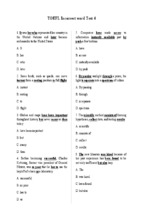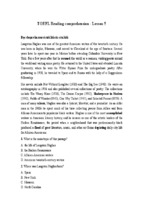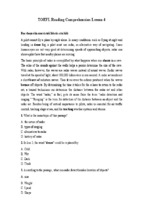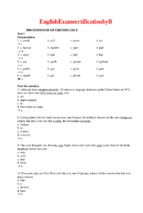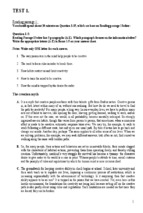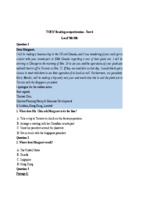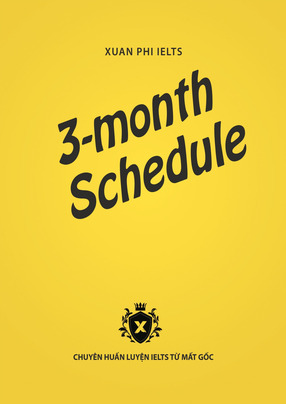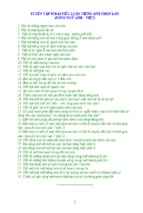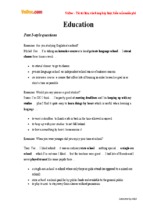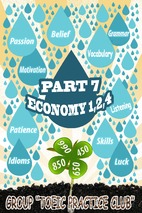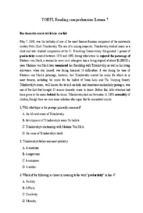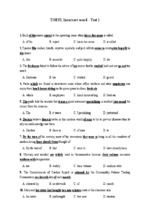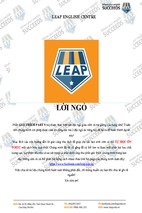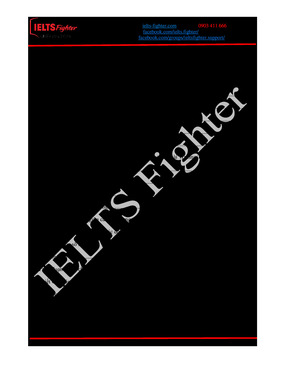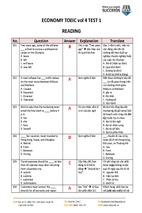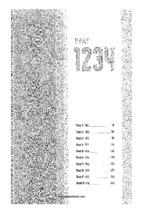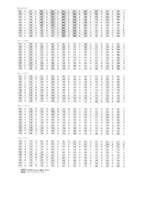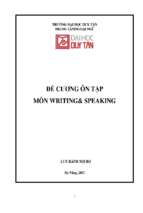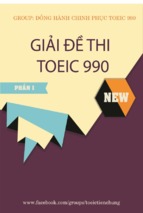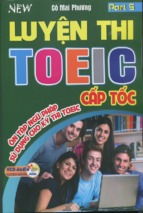IELTS PLANET PRESENTS
IELTS QUANG THẮNG
IELTS
READING
HỆ THỐNG BÀI TẬP KHOÁ HỌC IELTS READING
ĐƠN GIẢN VÀ HIỆU QUẢ
H
So
ạ
n
th
ả
o
ơ
b
n
ở
i
100
trang
Quang
Th
bài
ắ
ng
t
-
ậ
Reading
IELTS Planet 2016
-
p
9.0
Các bài tập trong quyển Bài tập này được trích từ các sách IELTS Cambridge.
Hướng dẫn sử dụng Khóa học online
"IELTS Reading đơn giản và hiệu quả"
Chào các bạn, mình là Quang Thắng - chính là giảng viên thực hiện khóa học Reading
này. Mình rất cảm ơn các bạn đã tin tưởng mình và đăng ký tham gia khóa học. Sau đây
sẽ là một số điều các bạn cần lưu ý khi học khóa học này.
- Khóa học sẽ bao gồm gần 20 video bài giảng. Vì mình đã sắp xếp bài giảng theo thứ tự
logic và khoa học theo từng bước, các bạn cần xem lần lượt các video từ đầu đến cuối
chứ không nên bỏ cách.
- Trong khóa học này, mình sẽ giao bài tập rất nhiều (khóa học chủ yếu là luyện làm đề
theo các chiến thuật mình hướng dẫn và sau đó chữa đề). Các bạn cần làm đầy đủ tất
cả các bài tập theo lộ trình mình hướng dẫn qua từng video. Chú ý rằng nếu các bạn
không làm đủ bài tập một cách nghiêm túc, khả năng các bạn đạt được mục tiêu tăng ít
nhất 1.0 Reading sau khóa học sẽ khó khăn hơn.
- Các bài giảng trong video mình giảng theo tốc độ trung bình. Nếu bạn nào thấy hơi
nhanh thì nên tua đi tua lại những phần quan trọng để hiểu bài rõ hơn. Nếu như bạn
nào trình độ khá mà thấy mình giảng hơi chậm và kĩ thì kiên nhẫn một chút :D
- Với các bài tập mình đều có phần Đáp án giải thích chi tiết và Bảng so sánh từ khóa.
Đây là công cụ cực hữu ích giúp các bạn cải thiện vốn từ vựng. Các bạn nhớ phải học
thật kĩ các Bảng từ khóa này sau mỗi bài học nhé.
Tham gia group facebook
Một trong những điểm hay nhất trong khóa học này đó là các bạn sẽ có thể dễ dàng
tương tác với giảng viên - là mình (khác với các khóa học online khác). Mình đã lập ra 1
group facebook cho tất cả các bạn đã đăng ký tham gia khóa học. Trong group facebook
này mình sẽ: giải đáp các câu hỏi liên quan đến khóa học Reading, và thường xuyên post
các bài tập nhỏ để các bạn luyện tập, nhằm giúp đạt hiệu quả tối đa.
Cách tham gia group facebook như sau:
Sau khi các bạn đã hoàn thành xong các bước thanh toán và nhận được email xác nhận
"Đơn hàng thanh toán thành công" từ IELTS Planet, các bạn chụp ảnh lại email này, sau
đó gửi cho mình ảnh này kèm theo các thông tin: Họ tên, Email (cái mà các bạn dùng để
đăng ký khóa học), và Mã số đơn hàng (Order number). Các bạn gửi qua inbox vào
fanpage IELTS Quang Thắng (facebook.com/ieltsquangthang) hoặc facebook cá nhân của
mình là Trần Quang Thắng (facebook.com/quangthangtran1992). Sau đó mình sẽ xác
nhận và add các bạn vào group.
Quy định khi post câu hỏi trên group:
Các bạn sẽ có thể post tất cả những thắc mắc liên quan đến nội dung khóa học IELTS
Reading của mình.
Riêng với trường hợp nếu các bạn muốn hỏi về các câu hỏi cụ thể trong các đề Reading
(ví dụ có câu nào các bạn đọc đáp án xong vẫn không hiểu, hoặc có câu nào các bạn
không làm được), các bạn có thể hỏi trong số các đề mình giao trong nội dung Khóa
học, và cả những đề nằm ngoài Khóa học, nhưng với các điều kiện sau:
1. Câu hỏi của bạn phải nằm trong bộ sách chính thức của Cambridge (bao gồm các
quyển Cam 5-11 và quyển The Official Cambridge Guide to IELTS). Các câu hỏi ở những
sách khác mình sẽ không ưu tiên giải đáp vì đó không phải là sách chính thức, cách ra đề
có thể sẽ khác với đề thi thật).
2. Khi hỏi, các bạn vui lòng post đủ Câu hỏi và Câu tương ứng trong passage mà các bạn
đã tìm. Các bạn không post nội dung như thế này "Cho mình hỏi câu 5 trang 69 quyển
Cam 6" nhé.
Kết luận:
Nhìn chung, mình sẽ cố gắng hết mức có thể để có thể mang lại tối đa hiệu quả của khóa
học này cho các bạn. Tuy nhiên, khi đưa ra khóa học chắc chắn mình không thể tránh
khỏi những sai sót. Mình mong các bạn nếu như thấy có điều gì chưa ổn về khóa học
này, hãy góp ý cho mình một cách thiện chí để mình có những điều chỉnh kịp thời.
Một lần nữa cảm ơn các bạn đã đăng ký tham gia khóa học. Chúc các bạn học tốt và có
thể đạt được kết quả IELTS như mong muốn.
IELTS Quang Thắng
BÀI 2: PHÂN TÍCH TỪ KHÓA TRONG CÂU HỎI
Phân tích các từ khóa loại 1 và loại 2 trong các câu hỏi dưới đây. Với các từ khóa loại 2,
bạn hãy đưa ra một vài dự đoán về các cách paraphrase trong passage.
1. There was little improvement in athletic performance before the twentieth
century.
2. Teenagers whose parents smoke are at risk of getting lung cancer at some time
during their lives.
3. Thirty per cent of deaths in the United States are caused by smoking related
diseases.
4. Many people carry out research in a mistaken way.
5. It is currently possible to measure the pollution coming from individual vehicles
whilst they are moving.
6. Residents of Los Angeles are now tending to reduce the yearly distances they
travel by car.
7. Charging drivers for entering certain parts of the city has been successfully done
in Cambridge, England
8. Archaeologists went back to the site to try and find the missing northern end of
the boat.
9. Evidence found in 2004 suggested that the Bronze-Age Boat had been used for
trade.
10. Shirase's original ambition was to travel to the North Pole.
11. Some Japanese officials thought Shirase's intention to travel to the South Pole
was pointless.
12. Shirase found it easy to raise the money he needed for his trip to the South Pole.
13. In the future, farmers are likely to increase their dependency on chemicals.
14. An important concern for scientists is to ensure that robots do not seem
frightening.
15. It will take considerable time for modern robots to match the ones we have
created in films and books.
16. Our ability to deal with a lot of input materials has improved over time.
BÀI 3: TÌM VỊ TRÍ THÔNG TIN TRONG PASSAGE
Tìm và gạch chân các đoạn chứa thông tin tương ứng với từng câu hỏi.
PASSAGE 1
Insects, birds and fish tend to be the creatures that humans feel furthest from. Unlike many
mammals they do not engage in human-like behaviour. The way they swarm or flock
together does not usually get good press coverage either: marching like worker ants might
be a common simile for city commuters, but it's a damning, not positive, image. Yet a new
school of scientific theory suggests that these swarms might have a lot to teach us.
American author Peter Miller explains, 'I used to think that individual ants knew where they
were going, and what they were supposed to do when they got there. But Deborah Gordon,
a biologist at Stanford University, showed me that nothing an ant does makes any sense
except in terms of the whole colony. Which makes you wonder if, as individuals, we don't
serve a similar function for the companies where we work or the communities where we
live.' Ants are not intelligent by themselves. Yet as a colony, they make wise decisions. And
as Gordon discovered during her research, there's no one ant making decisions or giving
orders.
Take food collecting. No ant decides, 'There's lots of food around today; lots of ants should
go out to collect it.' Instead, some foragers go out, and as soon as they find food, they pick
it up and come back to the nest. At the entrance, they brush past reserve foragers, sending
a 'go out' signal. The faster the foragers come back, the more food there is and the faster
other foragers go out, until gradually the amount of food being brought back diminishes. An
organic calculation has been made to answer the question, 'How many foragers does the
colony need today?' And if something goes wrong – a hungry lizard prowling around for an
ant snack, for instance – then a rush of ants returning without food sends waiting reserves a
'Don't go out' signal.
Câu hỏi
1. Birds and fish's ways of behaving are not similar to those of people.
2. From her study, Gordon found out that no individual ant has leadership roles.
3. When forager ants have already located food, they take it and return to where they
live.
PASSAGE 2
William Henry Perkin was born on March 12, 1838, in London, England. As a boy,
Perkin’s curiosity prompted early interests in the arts, sciences, photography, and
engineering. But it was a chance stumbling upon a run-down. yet functional, laboratory
in his late grandfathers home that solidified the young man`s enthusiasm for chemistry.
As a student at the City of London School, Perkin became immersed in the study of
chemistry. His talent and devotion to the subject were perceived by his teacher, Thomas
Hall, who encouraged him to attend a series of lectures given by the eminent scientist
Michael Faraday at the Royal Institution. Those speeches tired the young chemist`s
enthusiasm further, and he later went on to attend the Royal College of Chemistry,
which he succeeded in entering in 1853, at the age of 15.
At the time of Perkin’s enrollment the Royal College of Chemistry was headed by the
noted German chemist August Wilhelm Hofmann. Perkin’s scientific gifts soon caught
Hofmann’s attention and, within two years, he became Hofmann’s youngest assistant.
Not long after that, Perkin made the scientific breakthrough that would bring him both
fame and fortune.
At the time, quinine was the only viable medical treatment for malaria. The drug is
derived from the bark of the cinchona tree, native to South America and by 1856
demand for the drug was surpassing the available supply. Thus, when Hofmann made
some passing comments about the desirability of a synthetic substitute for quinine. it
was unsurprising that his star pupil was moved to take up the challenge.
During his vacation in 1856, Perkin spent his time in the laboratory on the top floor of
his family's house. He was attempting to manufacture quinine from aniline, an
inexpensive and readily available coal tar waste product. Despite his best efforts,
however, he did not end up with quinine. Instead, he produced a mysterious dark
sludge. Luckily, Perkins scientific training and nature prompted him to investigate the
substance further. Incorporating potassium dichromate and alcohol into the aniline at
various stages of the experimental process, he finally produced a deep purple solution.
And, proving the truth of the famous scientist Louis Pasteur`s words 'chance favors only
the prepared mind'. Perkin saw the potential of his unexpected find.
Historically. textile dyes were made from such natural sources as plants and animal
excretions. Some of these, such as the glandular mucus of snails, were difficult to obtain
and outrageously expensive. Indeed, the purple colour extracted from a snail was once
so costly that in society at the time only the rich could afford it. Further, natural dyes
tended to be muddy in hue and fade quickly. It was against this backdrop that Perkin‘s
discovery- was made.
Câu hỏi
1. Perkin soon developed his passions for several subjects when he was a little child.
2. Perkin's lecturer was the person who recognised his ability and dedication as a
student of chemistry.
3. Perkin made the discovery that made him rich and famous subsequent to becoming
an assistant of Hofmann.
4. The tree from which quinine is derived grow in South America.
5. Perkin hoped to produce quinine from a coal tar waste product.
6. A well-known person claimed that luck only comes to a person who has worked hard.
PASSAGE 3
B For the Inuit the problem is urgent. They live in precarious balance with one of the
toughest environments on earth. Climate change, whatever its causes, is a direct threat
to their way of life. Nobody knows the Arctic as well as the locals, which is why they are
not content simply to stand back and let outside experts tell them what's happening. In
Canada, where the Inuit people are jealously guarding their hard-won autonomy in the
country's newest territory, Nunavut, they believe their best hope of survival in this
changing environment lies in combining their ancestral knowledge with the best of
modern science. This is a challenge in itself.
C The Canadian Arctic is a vast, treeless polar desert that's covered with snow for
most of the year. Venture into this terrain and you get some idea of the hardships facing
anyone who calls this home. Farming is out of the question and nature offers meagre
pickings. Humans first settled in the Arctic a mere 4,500 years ago, surviving by
exploiting sea mammals and fish. The environment tested them to the limits: sometimes
the colonists were successful, sometimes they failed and vanished. But around a
thousand years ago, one group emerged that was uniquely well adapted to cope with
the Arctic environment. These Thule people moved in from Alaska, bringing kayaks,
sleds, dogs, pottery and iron tools. They are the ancestors of today's Inuit people.
D Life for the descendants of the Thule people is still harsh. Nunavut is 1.9 million
square kilometres of rock and ice, and a handful of islands around the North Pole. It's
currently home to 2,500 people, all but a handful of them indigenous Inuit. Over the
past 40 years, most have abandoned their nomadic ways and settled in the territory's 28
isolated communities, but they still rely heavily on nature to provide food and clothing.
Provisions available in local shops have to be flown into Nunavut on one of the most
costly air networks in the world, or brought by supply ship during the few ice-free weeks
of summer. It would cost a family around £7,000 a year to replace meat they obtained
themselves through hunting with imported meat. Economic opportunities are scarce,
and for many people state benefits are their only income.
Câu hỏi
1. Inuit people are living in very harsh weather conditions.
2. When you visit the Canadian Arctic, you can immediately understand the problems
faced by people living in this area.
3. For thousands of years after arriving, they have had to rely on catching marine species
as a means of sustenance.
4. For the present inhabitants, living continues to be a struggle.
PASSAGE 4
B Odours are also essential cues in social bonding. One respondent to the survey
believed that there is no true emotional bonding without touching and smelling a loved
one. In fact, infants recognise the odours of their mothers soon after birth and adults
can often identify their children or spouses by scent. In one well-known test, women
and men were able to distinguish by smell alone clothing worn by their marriage
partners from similar clothing worn by other people. Most of the subjects would
probably never have given much thought to odour as a cue for identifying family
members before being involved in the test, but as the experiment revealed, even when
not consciously considered, smells register.
C In spite of its importance to our emotional and sensory lives, smell is probably the
most undervalued sense in many cultures. The reason often given for the low regard in
which smell is held is that, in comparison with its importance among animals, the
human sense of smell is feeble and undeveloped. While it is true that the olfactory
powers of humans are nothing like as fine as those possessed by certain animals, they
are still remarkably acute. Our noses are able to recognise thousands of smells, and to
perceive odours which are present only in extremely small quantities.
D Smell, however, is a highly elusive phenomenon. Odours, unlike colours, for instance,
cannot be named in many languages because the specific vocabulary simply doesn't
exist. 'It smells like ... ,' we have to say when describing an odour, struggling to express
our olfactory experience. Nor can odours be recorded: there is no effective way to
either capture or store them over time In the realm of olfaction, we must make do with
descriptions and recollections. This has implications for olfactory research.
E Most of the research on smell undertaken to date has been of a physical scientific
nature. Significant advances have been made in the understanding of the biological and
chemical nature of olfaction, but many fundamental questions have yet to be answered.
Researchers have still to decide whether smell is one sense or two - one responding to
proper odours and the other registering odourless chemicals in the air. Other
unanswered questions are whether the nose is the only part of the body affected by
odours, and how smells can be measured objectively given the nonphysical
components. Questions like these mean that interest in the psychology of smell is
inevitably set to play an increasingly important role for researchers.
F However, smell is not simply a biological and psychological phenomenon. Smell is
cultural, hence it is a social and historical phenomenon. Odours are invested with
cultural values: smells that are considered to be offensive in some cultures may be
perfectly acceptable in others. Therefore, our sense of smell is a means of, and model
for, interacting with the world. Different smells can provide us with intimate and
emotionally charged experiences and the value that we attach to these experiences is
interiorised by the members of society in a deeply personal way. Importantly, our
commonly held feelings about smells can help distinguish us from other cultures. The
study of the cultural history of smell is, therefore, in a very real sense, an investigation
into the essence of human culture.
Câu hỏi
1. Tests have shown that odours can help people recognise the clothes belonging to
their husbands and wives.
2. Certain linguistic groups may have difficulty describing smell because they lack the
appropriate lexical items.
3. Scientists have yet to discovered if smells only have impacts on the nose.
4. Odours regarded as unpleasant in certain cultures are not regarded as unpleasant in
others.
BÀI 4: DẠNG GAP FILLING
Ví dụ:
1. For thousands of years they had to rely on catching ________ and _________
as a means of sustenance.
Passage:
Humans first settled in the Arctic a mere 4,500 years ago, surviving by exploiting
sea mammals and fish.
2. The territory of Nunavut consists of little more than ice, rock and a few
_________ .
Passage:
Nunavut is 1.9 million square kilometers of rock and ice, and a handful of islands
around the North Pole.
3. In recent years, many of them have been obliged to give up their ________
lifestyle, but they continue to depend mainly on ____________ for their food and
clothes.
Passage:
Over the past 40 years, most have abandoned their nomadic ways and settled in
the territory’s 28 isolated communities, but they still rely heavily on nature to
provide food and clothing.
4. Over two thousand years ago, kites were used in China as weapons, as well as
for sending ___________ .
Passage:
And other ancient civilizations certainly knew about kites; as early as 1250 BC, the
Chinese were using them to deliver messages and dump flaming debris on their
foes.
5. Savoury is a better-known word for ________.
Passage:
Certainly, our mouths and tongues have taste buds, which are receptors for the
five basic flavors: sweet, salty, sour, bitter, and umami, or what is more
commonly referred to as savoury.
6. The tongue was originally developed to recognise the unpleasant taste of
_________ .
Passage:
But our tongues are inaccurate instruments as far as flavor is concerned. They
evolved to recognise only a few basic tastes in order to quickly identify toxins,
which in nature are often quite bitter or acidly sour.
7. Gordon Shepherd uses the word 'neurogastronomy' to draw together a number
of __________ related to the enjoyment of eating.
Passage:
Shepherd has come up with the term 'neurogastronomy' to link the disciplines of
food science, neurology, psychology, and anthropology with the savory elements
of eating, one of the most enjoyed of human experiences.
8. Zhang refers to his business as a _______________.
Passage:
When asked why he decided to start a construction company, Zhang replies, 'It's
not a construction company. It's a structural revolution.'
9. In the late eighties, ___________ were holding back industrial progress in
China.
Passage:
Towards the end of the 1980s, China's economy was expanding past the capacity
of the nation's electricity grid, she explains. Power shortages were becoming a
serious obstacle to growth.
10. In addition to power and cost benefits, Broad's AC units improve
____________________ .
Passage:
Broad's large air-conditioning (AC) units fueled by natural gas could help
companies ease their electricity load, reduce overheads, and enjoy more reliable
climate control into the bargain.
PASSAGE 3
The sudden death of her husband in 1906 was a bitter blow to Marie Curie, but was also a
turning point in her career: henceforth she was to devote all her energy to completing alone
the scientific work that they had undertaken. On May 19, 1906, she was appointed to the
professorship that had been left vacant on her husband's death, becoming the first woman to
teach at the Sorbonne. In 1911 she was awarded the Nobel Prize for Chemistry for the isolation
of a pure form of radium.
During World War I, Marie Curie, with the help of her daughter Irene, devoted herself to the
development of the use of X—radiography, including the mobile units which came to be known
as 'little Curies', used for the treatment of wounded soldiers. In 1918 the Radium Institute,
whose staff Irene had joined, began to operate in earnest, and became a centre for nuclear
physics and chemistry. Marie Curie, now at the highest point of her fame and, from 1922, a
member of the Academy of Medicine, researched the chemistry of radioactive substances and
their medical applications
ln 1921, accompanied by her two daughters, Marie Curie made a triumphant journey to the
United States to raise funds for research on radium. Women there presented her with a gram
of radium for her campaign. Marie also gave lectures in Belgium. Brazil, Spain and
Czechoslovakia and, in addition, had the satisfaction of seeing the development of the Curie
Foundation in Paris. and the inauguration in 1932 in Warsaw of the Radium Institute, where her
sister Bronia became director.
One of Marie Curie's outstanding achievements was to have understood the need to
accumulate intense radioactive sources, not only to treat illness but also to maintain an
abundant supply for research. The existence in Paris at the Radium Institute of a stock of grams
of radium made a decisive contribution to the success of the experiments undertaken in the
years around 1930. This work prepared the way for the discovery of the neutron by Sir James
Chadwick and, above all, for the discovery in 1934 by Irene and Frédéric Joliot- Curie of artificial
radioactivity. A few months after this discovery, Marie Curie died as a result of leukaemia
caused by exposure to radiation. She had often carried test tubes containing radioactive
isotopes in her pocket, remarking on the pretty blue-green light they gave off.
Her contribution to physics had been immense, not only in her own work, the importance of
which had been demonstrated by her two Nobel Prizes, but because of her influence on
subsequent generations of nuclear physicists and chemists.
- Xem thêm -

